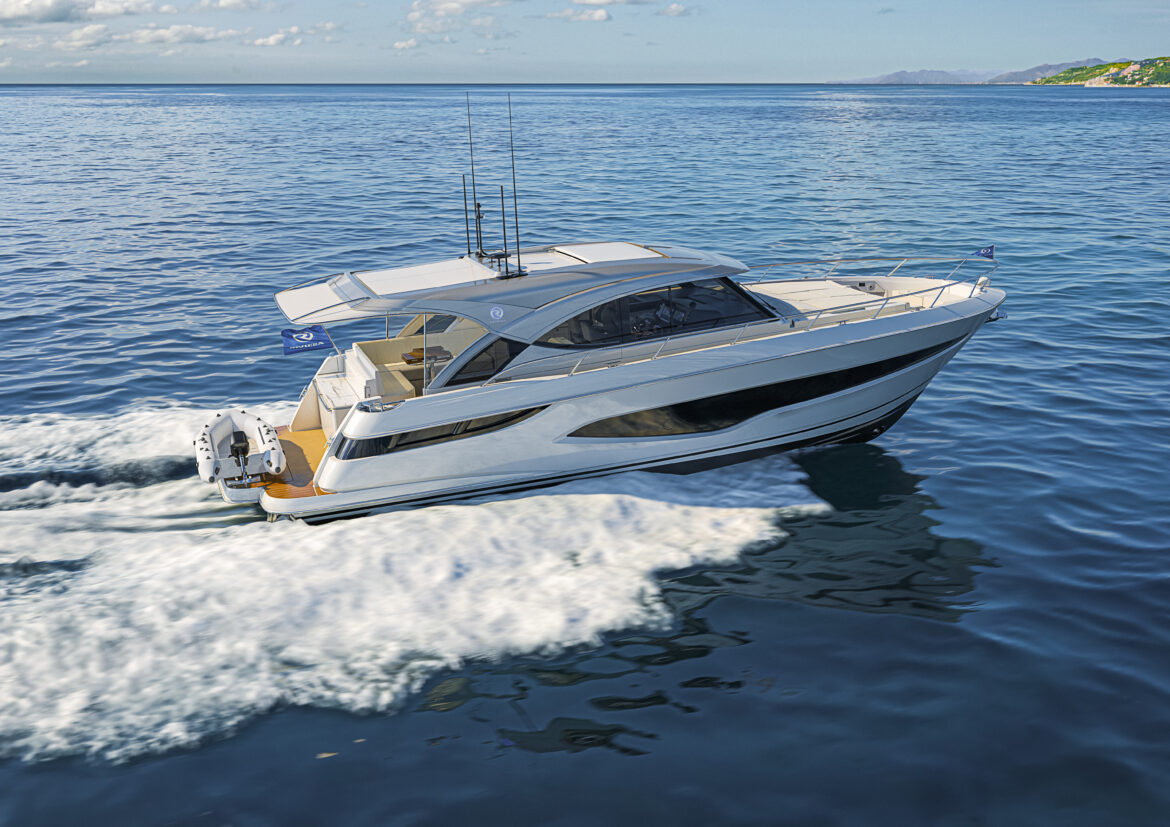SMOOTH OPERATOR
Riviera smoothly moves forward to contemporary design in this Euro-styled model, reports Kevin Green. Swapping an open cockpit found on its SUV range or the raised aft deck found on its Sport Yacht range for a fully covered yet open helm and deck makes the first of many bold statements on this new Sports Express model from Riviera. So, this new design, 4300, has a lot resting on its shoulders.
Attracting new people to the Riviera family of yacht owners, while maintaining the company’s bluewater, sturdy offshore hull designs, and utilising the proven Volvo Penta IPS system were all part of the design brief.
As Rodney Longhurst, the owner of Riviera explained at the models launch during the Sanctuary Cove Boat Show, more integration with our water world has been paramount in this new design: “Boating is all about enjoying that special place and sharing family time together; to meet up with friends, relax, explore, swim, snorkel or paddleboard. This is where the Sports Express excels as the entire stern of the yacht is free and open to allow exceptional access to the water for your maximum enjoyment.”
Another key to this design concept is speed and the ability to get there at over 30 knots, should the need arise; thus, the ‘Sports’ designation is well earned.
SPORTS DECK
Stepping aboard the first hull gave me quite a surprise, because of the fully covered aft deck hardtop that overhangs the stern, located electric barbecue centre, which Riviera has named the ‘Sea Deck’. Here, there are lockers beneath the barbecue benchtop for water toys – a deep one on port for two paddleboards while the starboard steps lift to reveal a locker for an underwater scooter (like a Seabob or the tender fuel tank). Outboard is room for a 2.7m inflatable on chocks, launched via the hydraulic platform.
Opening the solid gate that slides under the aft lounge takes me to what Riviera calls the ‘Sports Deck’, which effortlessly combines the best of the inside and outside living aspects of the 4300. Inside are two large L-shaped lounges, opposite one another, along with the second food preparation station or wet bar forward (which houses a drawer fridge, icemaker, sink, storage and benchtop space). There’s also a quality Fusion sound system to get the boat rockin’. The rear lounge features a stylish, handcrafted teak table that folds out to accommodate formal dining or lowers to create a generous daybed. This is a very versatile space, ideal for parents overseeing kids playing in the water, or for entertaining, with food being able to be prepared at the downstairs or the main deck galley or at the barbecue. Alternatively, sit-back and relax and if the sun’s rays are too fierce, simply turn on the aircon and watch some sport on the drop-down television. The entire area is weatherproof and finished in synthetic teak, so it can be easily hosed out.
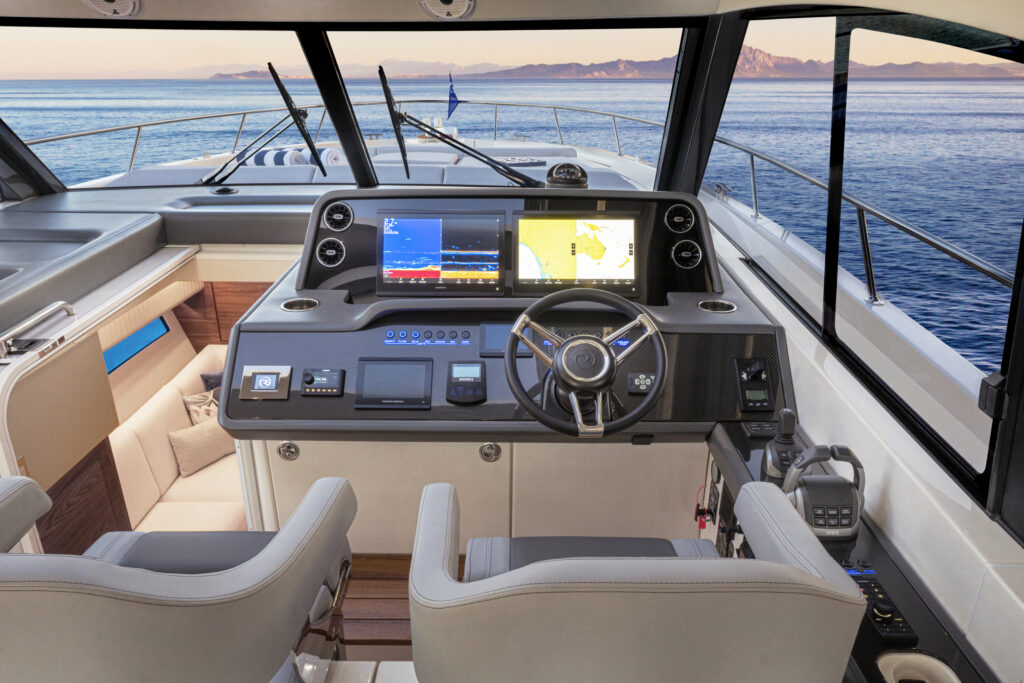
At the starboard located helm, other quality finishes include double bucket helm seats and an ergonomic dashboard with Garmin instrumentation. There are twin 12-inch screens for navigation and another 7-inch screen for monitoring the Volvo Penta engine systems. The throttles and IPS joystick are outboard, allowing the skipper to lean out the sliding window (or use the remote joystick on the port quarter, as I did) while berthing. The latest throttle controls come with several practical features. These include a slow speed option (similar to engaging low gear in a car) and a Cruise Control button to adjust RPM. This allows you to travel at a consistent, low speed in no-wash zones or when you want to take in the surroundings. Another button disengages the gearbox, so the engines can rev freely, a handy feature following service works. Yet another option available is Volvo Penta Assisted Docking, which is an excellent positionholding feature I’ve used on other Rivieras. Sitting on the comfy bolster seat, the view aft gives me clear sightlines when looking astern, and in fact, all round the ‘Sports Deck’. Anchoring is also done from here, with a Muir remote and chain counter screen as well. All other systems are managed by the Czone digital switching screen that offers five pre-programmed menu modes. Another handy feature is the portside door opposite the helm for easy access to the foredeck lounges, for docking or should the rode require checking.
Leaving the helm, I move out on the port side to explore the foredeck, where there’s a triple sunbed with drink holders on each side and a clever table that folds out from under the separate forward lounge. There’s a cool box for drinks, stereo speakers, USB charge points, and the option of a euro-style awning. You can relax because there’s a quality Australian Muir windlass with an optional 21kg Ultra stainless anchor and 50m of chain. Cleating is the usual oversized and quality Riviera standard, with gleaming stainless fairleads on the gunwales.
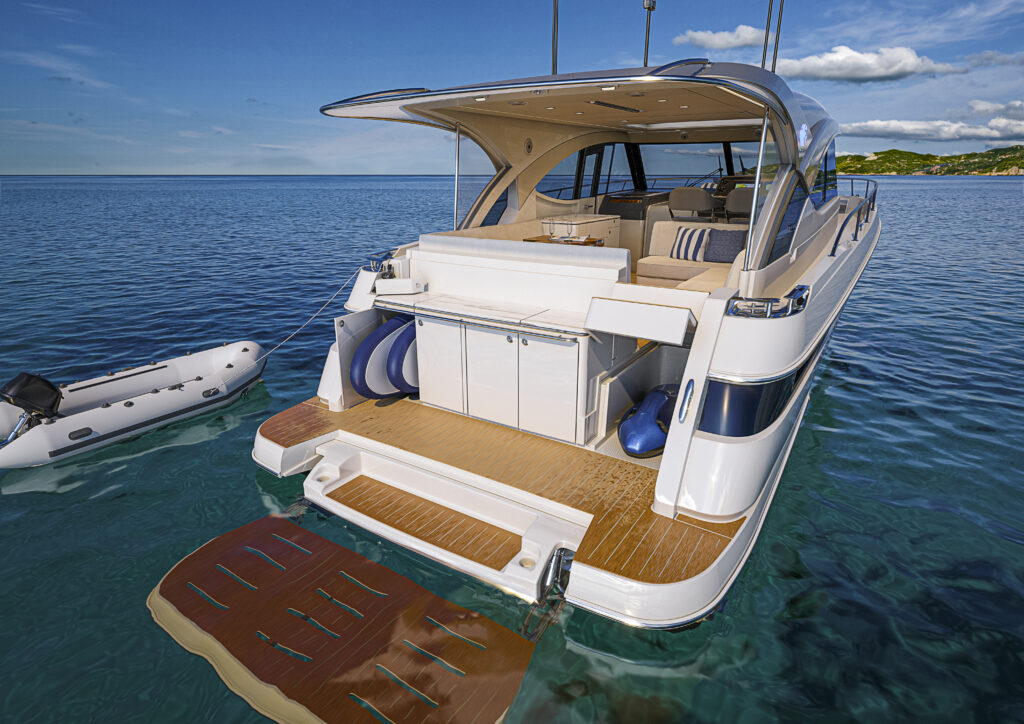
BELOW DECKS
Below decks is quite a revelation, featuring a central lounge and a starboard-side galley arrangement, with the master suite located forward and able to be closed off when required. The atrium entrance provides natural light, complemented by elongated portlights, which give the entire area, including the master suite, a bright and airy feel. This 43-footer also has a second cabin aft. This downstairs lounge has L-shaped seating to port with a matching Ottoman, along with a bulkhead-mounted LED Smart TV and a handcrafted drinks cabinet, complete with stemware storage. Opposite is the galley, which has a fridge and freezer drawers, combination convection microwave oven, large sink, twin hob induction cooktop and rangehood. There’s extensive storage above and below the bench for all your pantry and galleyware. You can even add a dishwasher. Forward of the galley is the bathroom with vanity, head and separate shower stall. Finished in white gelcoat, with timber accents, the area is stylish and easily cleaned, and there is a stainless-steel framed opening porthole above the raised ceramic basin for ventilation.
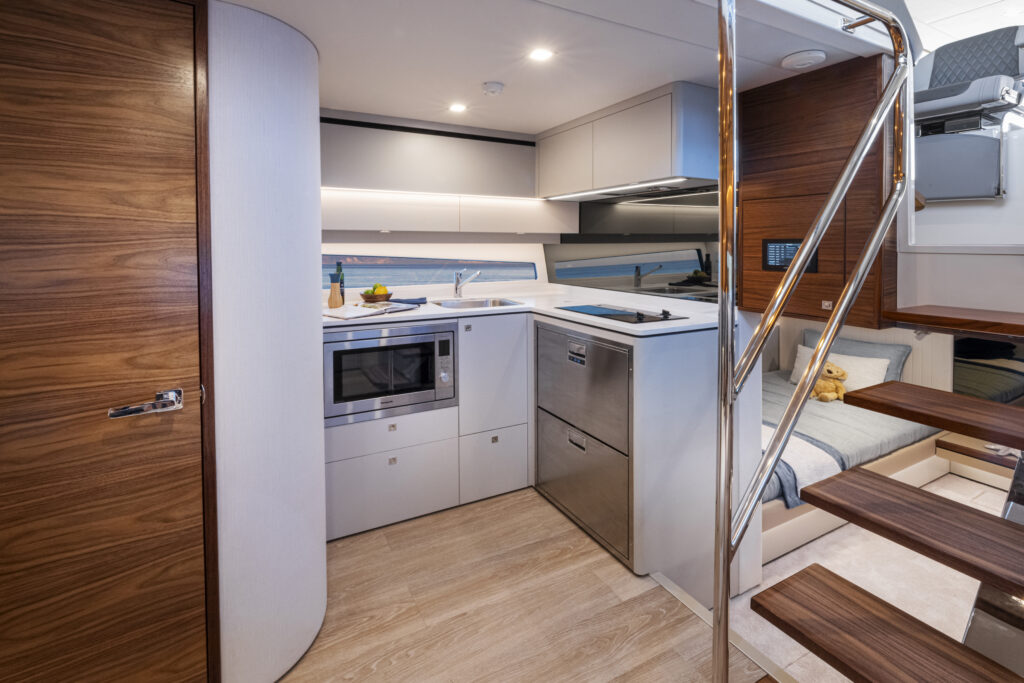
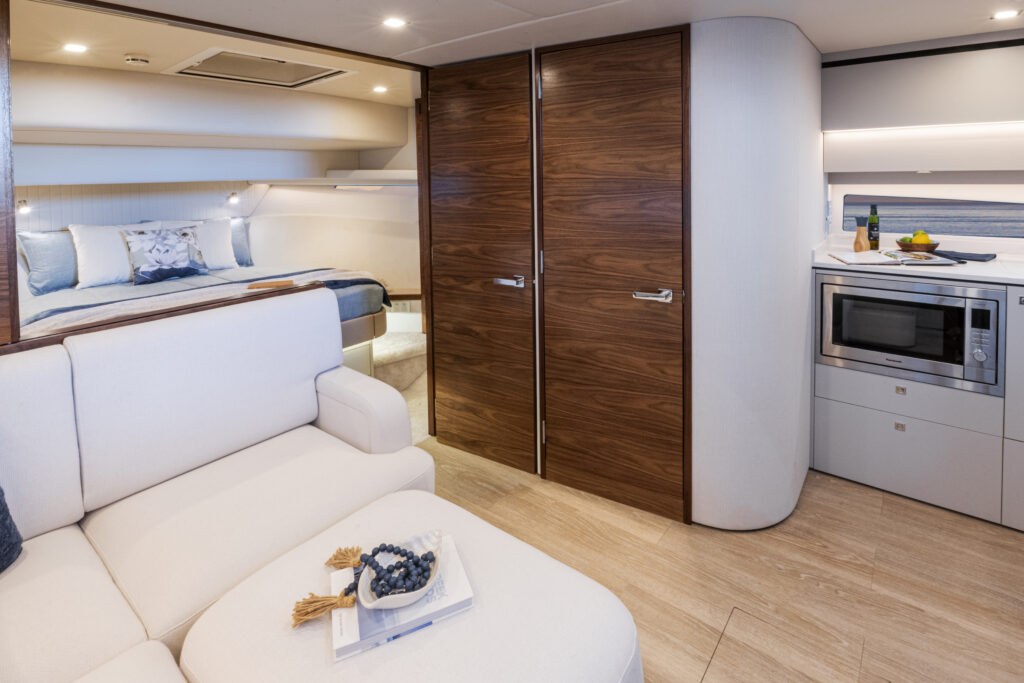
The owner’s forward master uses a wide entrance for casual living when there is just two of you aboard, but when guests join you, it can be easily closed off for full privacy. The internal volume is ample courtesy of the higher bow and raised foredeck sun pad, so there’s plenty of space for the oversized double island bed, which has four-drawer storage beneath. Along with dual cedar-lined wardrobes, there’s good storage for those long weekends on the coast. Natural light and air come from an opening porthole (with locking alarm). Quality finishes are again evident here with solid timber fixtures, sumptuous wool carpets and air-conditioning. The aft cabin uses the full beam of the 4300 and offers a double to port and king single to starboard. Volume is limited, but the large hull windows with portholes that open introduce fresh air and natural light, which makes the cabin welcoming.
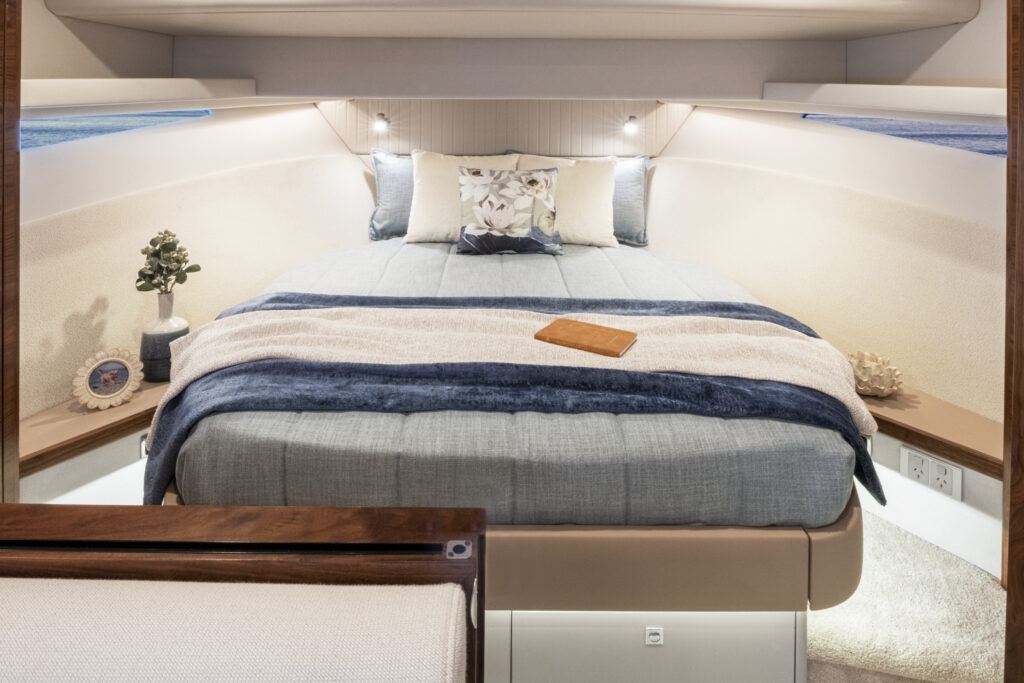
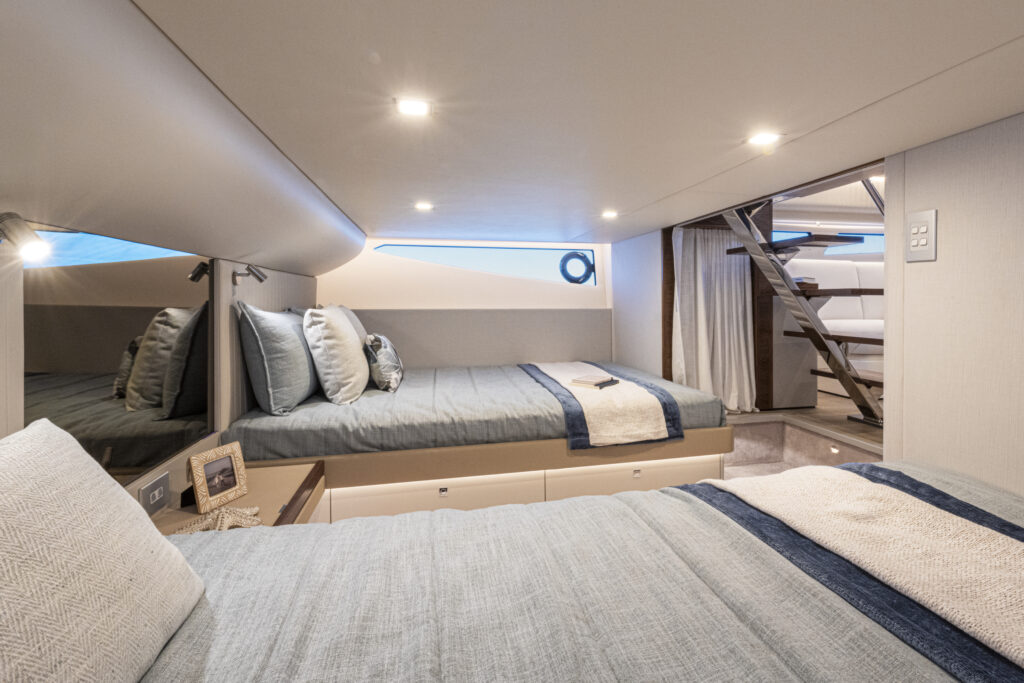
HULL AND SYSTEMS
The fibreglass hull is heavily laid up by hand, featuring a strong keel, a collision bulkhead at the bow, and a sandwich deck for insulation. It comes with an impressive seven-year warranty. Below the waterline, the 4300 uses solid GRP with foam core above to reduce weight. Stiffness is gained by using monolithic chines and independent compartment bulkheads. Climbing down to the engine room from the aft deck reveals a fairly busy space, dominated by the twin Volvo Penta D6-IPS600 480HP engines with single GRP fuel tank in front – easily checked here with sight gauge. I squeeze between the engines, to view pod drive transmissions, alongside house battery boxes off to port. I note that I can see most of the service points – filters and switchboards, plus 9.5 KVA Onan generator. The batteries are sensibly placed above bilge level, as are switches and other components, while the bilges have sufficient depth to cope with a leak should a skin fitting fail. The inboard bilge has the space for an optional Seakeeper gyro. Stored power is via safer Lithium Iron Phosphate batteries with an inbuilt safety Battery Management System. This is controlled by the trusty Czone digital switching system. Other monitoring uses cameras for the anchor, stern and engine room – integrated to the helm displays – plus there’s Sentinel remote monitoring and control. This is a comprehensive fit-out which gives the owner peace of mind.
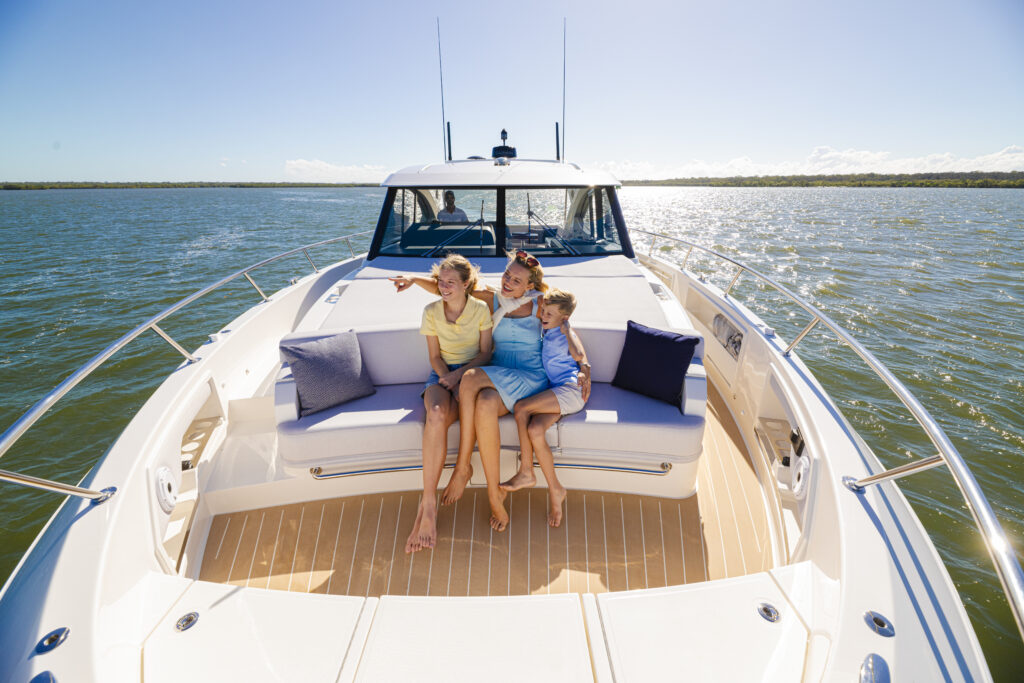
GOLD COAST VOYAGE
Departing a tight marina berth on the 4300 proved drama-free thanks to the fine control from the IPS and joystick control and the expertise of skipper Dean. This first hull is also fitted with an optional bow thruster, a welcome feature for many skippers who face tight berthing situations, but not really necessary on a smaller pod boat like this 4300. Clear of the marina, I took the helm as we motored along the Broadwater, a busy area thronging with jet skis and myriad other vessels. Clear views from the helm gave me the confidence to accelerate, which brought an instant response from the torquey 480HP Volvos, quickly putting us on the plane at about 16 knots. I then rounded a cardinal marker for a run south towards the Gold Coast skyscrapers at the 4300’s cruising speed (about 27 knots with 80% engine load, which used 156 L/PH) before turning east and out to sea. A small swell met us and put some spray on the wide front windscreens as a reminder that we were at sea, but apart from that the 4300 gave hardly a murmur so I accelerated to its top speed, at 33.5 knots, the Trim Assist tabs automatically putting the bow down to about 10% tilt which ensured clear views forward. Putting the helm down and the boat into a turn brought on a 20% heel, which nicely brought the 4300 hull around in a fairly tight turn for an IPS pod boat, giving a sporty, responsive feel. Seeking more swell, I criss-crossed our wake, which was done without any groans from the stiff hull; showing Riviera’s typically sturdy build while giving a lively overall feel.
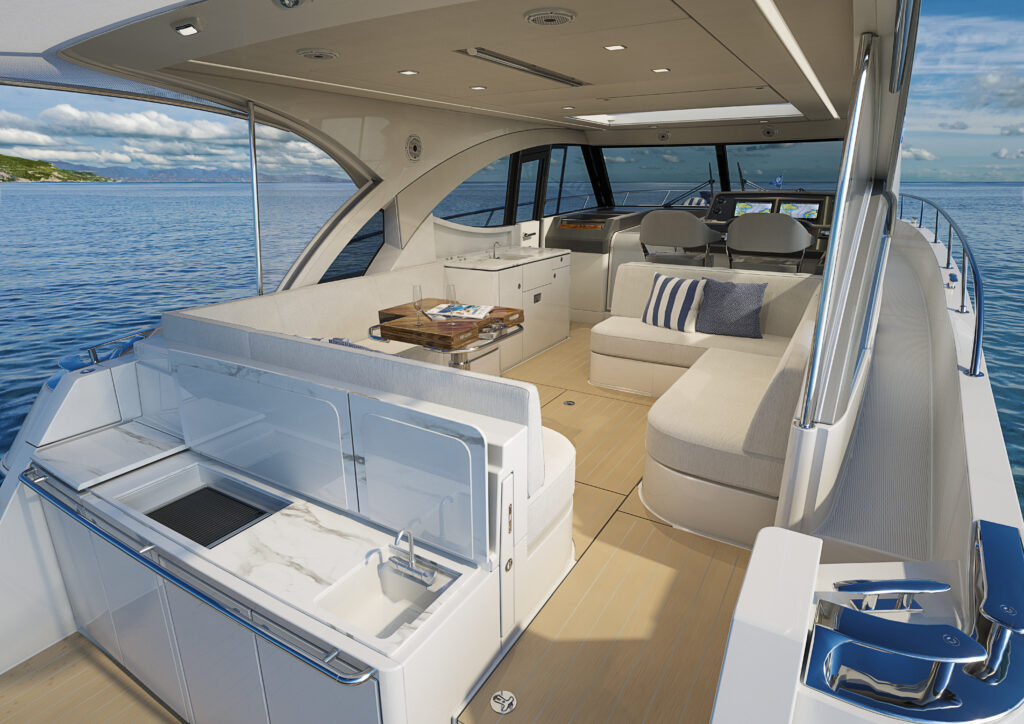
Approaching the marina, skipper Dean offered to let me berth the 4300, but before doing so I decided to practice some slow manoeuvres just outside the marina. Engaging the IPS joystick, I put the hull broadside to the 15-knot breeze and moved fore and aft, while also compensating for the tide – requiring two simultaneous movements of the joystick by twisting and moving it in the desired direction. Very intuitive. Which then gave me the confidence to back the 4300 into the tight marina berth; a typical scenario for an owner and done without dramas. In fact, the entire morning aboard the 4300 Sports Express was drama-free, enjoyable, and indeed sporty; so, its name is well-deserved.
SPECIFICATIONS
Overall Length 13.88m
Beam 4.45m
Draft 1.22m
Displacement 13,000kg
Fuel 1,200 L
Water 400 L
Holding Tank 80 L
Berths 5 Persons
PERFORMANCE DATA
RPM KNOTS LNM RANGE
600 3.5 3 1260
1000 5.9 8 97
1500 7.9 22 388
2000 9.1 55 179
2500 15 87 186
3000 22.3 119 202
3770 32.3 190 184


